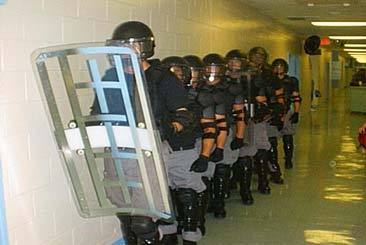|
|
| CERT to the rescue |
| By Arthur Nardi , Deputy Sheriff, Broward Sheriff's Office |
| Published: 07/23/2007 |
 Editor’s note: Guest contributor, and 17-year veteran Broward Sheriff’s Office Deputy Sheriff, Gene Nardi, writes about the importance of a CERT team.
Editor’s note: Guest contributor, and 17-year veteran Broward Sheriff’s Office Deputy Sheriff, Gene Nardi, writes about the importance of a CERT team.Today’s technology provides corrections professionals with safe and innovative methods to control an inmate’s violent behavior. Specialized units in a correctional facility, when deployed by properly trained personnel, can reduce officer and inmate injuries and reduce an agency’s reduce liability. Proper policies, training and deployment are paramount to a successful correctional emergency response team, or CERT, program inside and outside of your facilities. If your agency does not have a specialized unit trained to handle inmate movement, disturbances and uprisings, then it is behind the times. Even with the high-tech security revolution to control inmates, the risk of violent inmate behavior does not completely disappear. If there’s chance for inmate contact, a risk exists. There’s a good chance that inmates must also be moved from one location to another on occasion. Therefore, special teams trained to control them, especially high-risk inmates, are a must. If you do not have a CERT team in place that can be called upon when a critical incident occurs, or when a high-profile inmate must be transported to another county, then you’re doing your community a disservice. If your facility relies on your local police department’s SWAT team, there may be a problem. The problem is, SWAT teams tend to have a much longer response time compared to a CERT team because a CERT team is already working in the facility. SWAT teams may not be as familiar with the layout of the facility as CERT officers, and SWAT may not be able to easily identify officers from inmates. They would have to depend on photographs and other resources. Tactics also differ when it comes to team movement and deployment. Specialized weapons and restraints will vary between SWAT and CERT teams. If your agency does not have an active CERT team, it may be beneficial to coordinate joint training sessions with the local SWAT team. Both units may depend on one another to successfully complete a mission.  CERT Deployment using Pepperball Systems Developing a CERT team takes time, but it can be done with a minimal investment. When you compare workman’s compensation claims, overtime, and law suit payouts versus the cost to implement a CERT team, you may find that, in the long run, it would be far less expensive to have a team in your facility. Some of the larger facilities around the nation have full-time CERT teams, meaning, they conduct special operations daily, such as inmate movement, “shakedowns,” inmate transportation, security details, and training. They can certainly justify a full-time team with housing 30,000 to 40,000 inmates. Most facilities only need a team that will hold a normal position in the facility, and be on-call for emergency operations. The size of your team and the amount of training should be based on what your facility needs are. Facility command should evaluate manpower versus average daily inmate population, and evaluate staff responsibilities to determine where team members would be necessary. Once it is determined that a team is needed, and the decision has been made to recruit members, select a team commander. This person should have an integral role in working with administration and in writing the policies on team operations and deployment.  CERT Deployment Training Exercise Policies should include team selection process, try-outs and training. This will ensure consistency with the annual selection of team members as members leave the team through promotions, retirement, etc. The selection process should include oral, physical and psychological tests. Depending on your agency, you may implement basic requirements on firearms proficiency and physical fitness prior to team selection as well. As a team is selected, training should be addressed immediately to prepare the team for missions they may have to carry out. It should be balanced based on the team’s responsibilities. Firearms, restraints, prisoner transport, perimeters, small arrest team tactics, cell extractions, bus extractions, special weapons, chemicals, distraction devices and less lethal munitions should be part of the regiment. Protective equipment and tactical gear selection are also important. Test and evaluate the latest equipment that’s available. If there are budget concerns, then check with military surplus. Sometimes they have respirators and other gear that can get your team started. Once the team is established and experienced, the agency will have more confidence of your team’s capabilities, and will therefore use the team more often for preventative measures. Some agencies have specific budgets for their CERT teams. This may take some time to accomplish. A great resource for information on new equipment is the annual The Office of Law Enforcement Technology Commercialization (OLETC) Mock Riot in Moundsville, West Virginia. Teams from all over the country participate in training scenarios, inside the old Moundsville Prison, testing the showcased gear, from protective equipment to weapons.  CERT Deployment Cell Extraction For a sheriff’s office that operates the county jails and patrols various municipalities throughout the county, CERT may be used for other functions outside the facilities as well. For instance, our detention department’s ERT team is now an active element on our road patrol’s Mobile Field Force. So in addition to processing and transporting arrests during civil unrest, the ERT now plays a more active role by being deployed as arrest teams, and by taking violent agitators into custody on the front line. This addition to the Field Force occurred during a Field Force training day when I was assigned to train the Field Force squads on small team arrest tactics. I demonstrated very similar tactics to what our cell extraction teams do in the facility, and the Field Force Commander, was impressed enough that he requested the ERT to be an official element of the Field Force. This is something that your agency may want to consider. It has worked very well for our agency through joint training and real-time experience during the 2003 FTAA in Miami and the 2004 OAS in Ft. Lauderdale. Now for the million dollar question; how often should a CERT team train? Again, it depends on the needs of your facility. If you have a CERT team to accommodate an accreditation requirement, then it would depend on what their requirements are. ACA requires that CERT teams train a minimum of forty hours annually. Remember, that your team is responsible for handling critical incidents that regular staff and resources are not capable of handling. So, the normal recommended training can vary from two days a month to eight hours a week. Remember to document and video record all training. If it’s not documented, it didn’t happen. The first thing any attorney will question is the training documentation of the team. Video recordings will help evaluate the facility layout and team tactics during training scenarios. As long as there are people incarcerated, there will be a need for corrections officers. Inmates are going to become violent. Knowing this risk, there will always be a need for specialized CERT personnel to handle these situations as they arise. Not only are they protecting staff and other inmates, they are protecting citizens. Arthur (Gene) Nardi is a 17-year veteran Deputy Sheriff with the Broward Sheriff’s Office having worked in corrections and road patrol. He is a full-time firearms and defensive tactics instructor for the Training Unit. Nardi served on the Dept. of Detention’s Emergency Response Team for seven years as an operator and the training coordinator. He can be contacted at Arthur_Nardi@Sheriff.org Related Resources: The Office of Law Enforcement Technology Commercialization (OLETC) National Institute of Corrections CERT information CERT Photos Below: CERT Deployment using Pepperball Systems CERT Deployment Training Exercise CERT Deployment Cell Extraction |
MARKETPLACE search vendors | advanced search

IN CASE YOU MISSED IT
|


Comments:
No comments have been posted for this article.
Login to let us know what you think